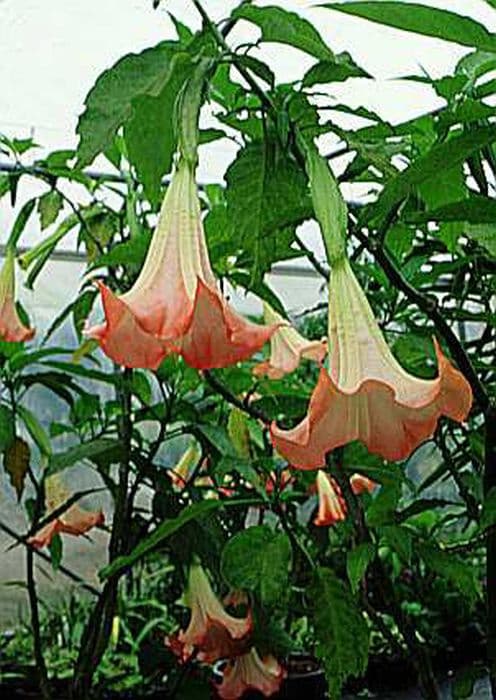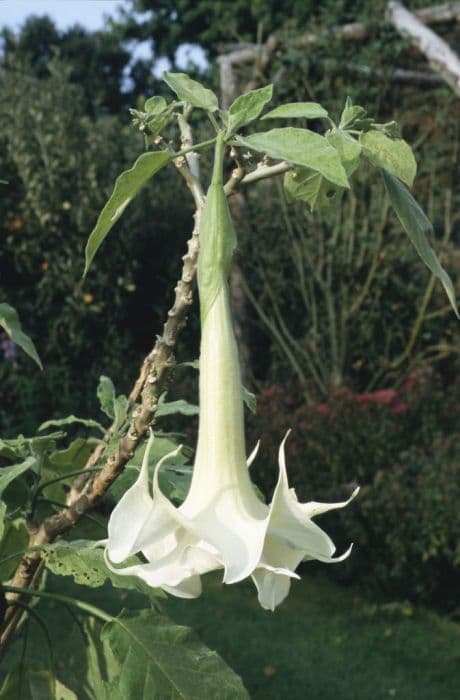Surfinia Petunia Surfinia Pink Vein = 'Suntosol' (Surfinia Series)
![petunia [Surfinia Pink Vein]](/_next/image?url=https%3A%2F%2Fplants-admin.emdemapps.com%2Fimages%2Fplants%2F%2Fimages%2F604b587034208.png&w=3840&q=75)
ABOUT
The Petunia Surfinia Pink Vein, belonging to the Surfinia Series, is a flowering plant known for its cascading growth habit, making it an ideal choice for hanging baskets and containers. This particular variety, characterized by its vibrant color and pattern, brandishes abundant, funnel-shaped flowers that boast a stunning bright pink hue intertwined with a pronounced pink venation, creating a striking veined appearance that distinguishes it from other petunias. The blooms are dense and significantly cover the trailing stems, offering a profusion of color throughout the blooming season. The foliage of the Petunia Surfinia Pink Vein is equally attractive, with its dark green leaves forming a lush backdrop that further accentuates the vibrancy of the flowers. This cultivar has a vigorous growth habit and is prized for its long-lasting, showy blossoms that are capable of providing a continuous display of color from spring until fall. Its trailing stems, adorned with flowers and foliage, create a tumbling effect that adds dynamic visual interest to any garden setting or outdoor space.
About this plant
 Names
NamesFamily
Solanaceae
Synonyms
Surfinia Petunia, Trailing Petunia, Surfinia Pink Vein Petunia
Common names
Petunia 'Suntosol'
 Toxicity
ToxicityTo humans
The Petunia is not known to be toxic to humans. In general, Petunias, including the ‘Suntosol’ variety, are considered safe and non-toxic. They do not contain substances known to cause serious harm if ingested. Accidental consumption of this plant is unlikely to result in poisoning or severe symptoms.
To pets
The Petunia is not considered toxic to pets. It is generally regarded as safe for dogs, cats, and other domestic animals if they happen to ingest parts of the plant. While not poisonous, ingestion of Petunias may still cause mild gastrointestinal discomfort or vomiting in some pets due to the novelty of the plant material in their diet, but serious cases of poisoning are not common.
 Characteristics
CharacteristicsLife cycle
Annuals
Foliage type
Deciduous
Color of leaves
Green
Flower color
Pink
Height
1 feet (0.3 meters)
Spread
2 feet (0.6 meters)
Plant type
Herb
Hardiness zones
9
Native area
South America
Benefits
 General Benefits
General Benefits- Easy to grow - The plant is known for its ease to cultivate, requiring minimal maintenance and care.
- Vibrant colors - It produces striking pink flowers with distinctive veining, adding a splash of color to any garden space.
- Continuous blooming - It offers a long flowering period from spring to fall, continually adding interest to the area it's planted in.
- Trailing habit - With a cascading growth habit, it is well-suited for hanging baskets and containers, providing a lush, overflowing look.
- Attracts pollinators - The blossoms attract beneficial pollinators like bees and butterflies, promoting a healthy garden ecosystem.
- Drought resistance - Once established, it demonstrates a good level of drought tolerance, making it suitable for warmer climates.
- Versatile use - It is versatile in landscaping, suitable for ground cover, borders, or as a feature plant in a mixed display.
 Medical Properties
Medical PropertiesThis plant is not used for medical purposes.
 Air-purifying Qualities
Air-purifying QualitiesThis plant is not specifically known for air purifying qualities.
 Other Uses
Other Uses- Photography Prop: Petunias can be used as a vibrant and attractive backdrop for macro or portrait photography sessions.
- Handmade Paper Inclusions: Dried petals of the petunia can be incorporated into handmade paper to add texture and color.
- Artistic Dye: Petunia petals can be boiled to extract natural dyes for fabrics or paper art.
- Educational Tool: Petunias can be used in schools for teaching students about plant growth cycles, pollination, and horticulture.
- Event Decor: Petunias can add a splash of color to special events and can be given as party favors to guests.
- Culinary Garnish: Although not commonly known for culinary uses, the petals of petunias can be used to garnish salads and desserts for an extra pop of color.
- Floral Art: Petunia flowers can be used in flower arranging competitions to create stunning and unique designs.
- Color Therapy: The vibrant hues of petunias can be utilized in color therapy practices for their calming and uplifting effects.
- Memory Gardens: Petunias can be planted in memory gardens as they are easy to care for and their continuous blooming can symbolize everlasting memories.
- Container Gardening Education: The petunia is ideal for demonstrating the principles of container gardening due to its adaptability and growth habits.
Interesting Facts
 Feng Shui
Feng ShuiThe Petunia is not used in Feng Shui practice.
 Zodiac Sign Compitability
Zodiac Sign CompitabilityThe Petunia is not used in astrology practice.
 Plant Symbolism
Plant Symbolism- Anger and Resentment: Petunias are often associated with feelings of anger and resentment, perhaps due to their somewhat intense colors and proliferation.
- Desire: The bright colors of the Petunia can symbolize a burning desire or passion in someone's heart.
- Soothing Presence: Despite some negative associations, Petunias might also be viewed as providing a comforting and soothing presence, representing peace of mind.
 Water
WaterSurfinia petunias require regular watering to keep their soil moist but not waterlogged. Water them thoroughly when the top inch of the soil feels dry to the touch, which might be every other day during the summer or less frequently during cooler months. These plants prefer a deep soaking rather than a light sprinkle, ensuring that the water reaches the root level. For potted plants, this might translate to approximately 16-24 ounces of water per watering session, depending on the size of the container and the environmental conditions. In hot weather or hanging baskets, which dry out faster, daily watering may be necessary.
 Light
LightSurfinia petunias thrive best in full sun conditions, receiving at least 6 to 8 hours of direct sunlight per day. They should be planted in a spot where they can receive morning and midday sun for optimum growth. While they can tolerate some partial shade, too little light may result in leggy plants and fewer flowers.
 Temperature
TemperatureSurfinia petunias prefer warmer temperatures and perform best when nighttime temperatures are consistently above 40 degrees Fahrenheit and daytime temperatures range from 60 to 80 degrees Fahrenheit. They can handle temperatures up to about 90 degrees Fahrenheit but will require more frequent watering in such heat. These petunias might not survive frost and should be protected or brought indoors if temperatures dip below 40 degrees Fahrenheit.
 Pruning
PruningRegularly deadheading Surfinia petunias promotes bushier growth and continuous blooming throughout the season. Remove faded or dead flowers weekly to encourage new growth and prevent the plant from putting energy into seed production. The best time for more significant pruning is mid-season when you can cut back leggy stems by a third to rejuvenate the plant and maintain a compact shape.
 Cleaning
CleaningAs needed
 Soil
SoilThe best soil mix for Surfinia petunias is light, well-draining potting soil with added perlite or vermiculite. They prefer a slightly acidic to neutral pH between 5.5 and 6.5. Ensure good fertility with a balanced, slow-release fertilizer mixed into the soil.
 Repotting
RepottingSurfinia petunias should be repotted annually, preferably in the spring as new growth begins. They enjoy fresh soil each year to support their vigorous growth and blooming.
 Humidity & Misting
Humidity & MistingSurfinia petunias flourish in average humidity conditions and do not require any special humidity adjustments. They are adaptable to the humidity levels typically found in outdoor environments.
 Suitable locations
Suitable locationsIndoor
Ensure bright light, regular watering, and monthly fertilizer.
Outdoor
Place in full sun, water regularly, and deadhead spent blooms.
Hardiness zone
9-11 USDA
 Life cycle
Life cycleThe Petunia Surfinia Pink Vein, a flowering plant, begins its life cycle when seeds are sown into well-drained soil in early spring after the danger of frost has passed. Germination occurs within 5 to 15 days in warm conditions with adequate moisture, leading to the development of seedlings. Once seedlings are established and have developed a few true leaves, they undergo growth and vegetative development, producing a bushy structure well-suited for flowering. Flower buds form and as temperatures rise in late spring to summer, profuse blooms of pink flowers with distinct veins open and will continue blooming until the first frost if deadheaded and well maintained. After flowering, the plant sets seeds that can be collected for the next growing season if not grown as a hybrid. The plant will eventually senesce and die with the onset of cold weather or after completing its annual growth cycle.
 Propogation
PropogationPropogation time
Spring-Summer
Petunia Surfinia Pink Vein, part of the Surfinia Series, is typically propagated through softwood cuttings. This method is favored because it maintains the characteristics of the parent plant, essential for hybrids such as 'Suntosol'. The most popular time to propagate through cuttings is late spring to early summer when the plant is actively growing. Cut a 3- to 4-inch (approximately 7.5 to 10 cm) length from a healthy stem, just below a node. Remove the lower leaves and dip the cut end in rooting hormone powder to encourage root development. Then, plant the cutting in a mixture of half peat and half perlite, ensuring the soil is kept moist but not waterlogged. Place the potted cutting in a warm, bright area out of direct sunlight until roots have established, usually within a few weeks.


![Calibrachoa [Aloha Classic Blue Sky]](/_next/image?url=https%3A%2F%2Fplants-admin.emdemapps.com%2Fimages%2Fplants%2F%2Fimages%2F604b636c3778b.png&w=640&q=75)
![Calibrachoa [Aloha Classic Gold]](/_next/image?url=https%3A%2F%2Fplants-admin.emdemapps.com%2Fimages%2Fplants%2F%2Fimages%2F604b6284c573e.png&w=640&q=75)
![Calibrachoa [Aloha Classic Tiki Soft Pink]](/_next/image?url=https%3A%2F%2Fplants-admin.emdemapps.com%2Fimages%2Fplants%2F%2Fimages%2F604b548e0a5ef.png&w=640&q=75)
![Calibrachoa [Cabaret Deep Yellow]](/_next/image?url=https%3A%2F%2Fplants-admin.emdemapps.com%2Fimages%2Fplants%2F%2Fimages%2F604b5f20ca3ef.png&w=640&q=75)
![Calibrachoa [Calibasket Radiant Orange]](/_next/image?url=https%3A%2F%2Fplants-admin.emdemapps.com%2Fimages%2Fplants%2F%2Fimages%2F604b536d43cb2.png&w=640&q=75)
![Calibrachoa [Caloha Classic Blue Velvet]](/_next/image?url=https%3A%2F%2Fplants-admin.emdemapps.com%2Fimages%2Fplants%2F%2Fimages%2F604b604884a75.png&w=640&q=75)
![Calibrachoa [Caloha Classic Honey White]](/_next/image?url=https%3A%2F%2Fplants-admin.emdemapps.com%2Fimages%2Fplants%2F%2Fimages%2F604b5f56e0beb.png&w=640&q=75)
![Calibrachoa [Caloha Classic Yellow Chocolate Ring]](/_next/image?url=https%3A%2F%2Fplants-admin.emdemapps.com%2Fimages%2Fplants%2F%2Fimages%2F604b538aede95.png&w=640&q=75)